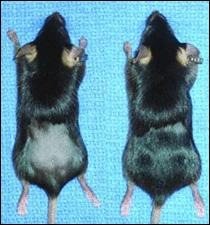Scientists at the University of Michigan Medical School have discovered that the transient activation of a protein called ß-catenin can induce new hair growth. The study is published in the May 15th issue of Genes & Development.
Adult hair follicles undergo a growth cycle consisting of periods of growth (anagen), regression (catagen), and rest (telogen). David Van Mater and colleagues (Drs. Frank Kooligs, Andrzej Dlugosz, and Eric Fearon) at the University of Michigan have demonstrated that the brief activation of ß-catenin in telogen-phase adult hair follicles is sufficient to initiate the anagen phase.
The ß-catenin protein is a key member of the Wnt signal transduction cascade, an important intracellular signaling pathway. The canonical Wnt signaling pathway involves the stabilization of ß-catenin protein, its subsequent accumulation in the cell, and its activation of Wnt target genes. Previous work has implicated Wnt/ß-catenin signaling in embryonic hair follicle development, postnatal follicle growth and maturation, and skin tumor formation. This new work provides important insight into the role of ß-catenin as a trigger for activating the normal growth of adult hair follicles.
The University of Michigan researchers generated transgenic mice expressing an inactive version of ß-catenin in their skin and hair follicles. Upon topical treatment of the mice with a chemical called 4-OHT, the exogenous ß-catenin protein is activated. Thus, through the cutaneous application of 4-OHT, the researchers could transiently activate ß-catenin signaling at will.
 |
To test the effect of ß-catenin signaling on adult hair growth, the researchers shaved the backs of telogen-phase transgenic and wild-type mice, and then applied 4-OHT once.
Within 15 days, the transgenic mice grew new hair, whereas wild-type still had none (see accompanying image). Furthermore, the new hair was histologically indistinguishable from normal hair, and progressed through the remainder of the growth cycle in stereotypical fashion. |
As Dr. Dlugosz explains, “Remarkably, we find that brief activation of ß-catenin in resting hair follicles is sufficient to trigger a normal follicle growth phase, followed by the expected regression and resting phases. ß-catenin acts specifically on epithelial hair follicle progenitor cells, triggering a highly coordinated program of proliferation followed by expansion into the multiple differentiated cell types that comprise the mature, growing hair follicle. In contrast to the effects of transient and regulated beta-catenin activation, prolonged activation of ß-catenin leads to uncontrolled growth and gross distortion of the hair follicle structure, underscoring the importance of precisely controlled signaling activity for normal follicle regeneration.”














